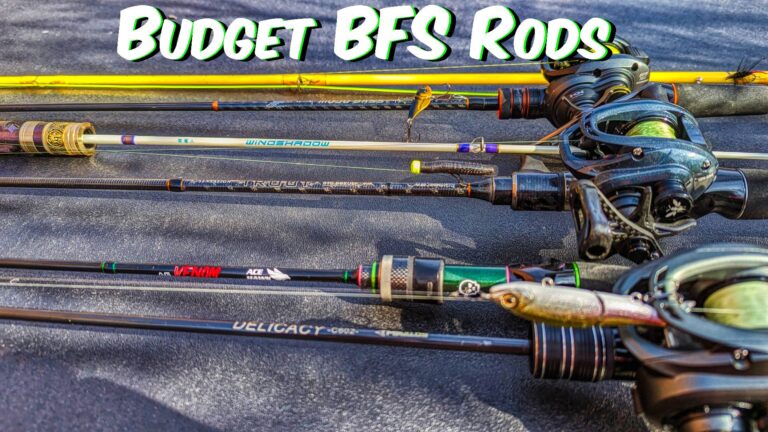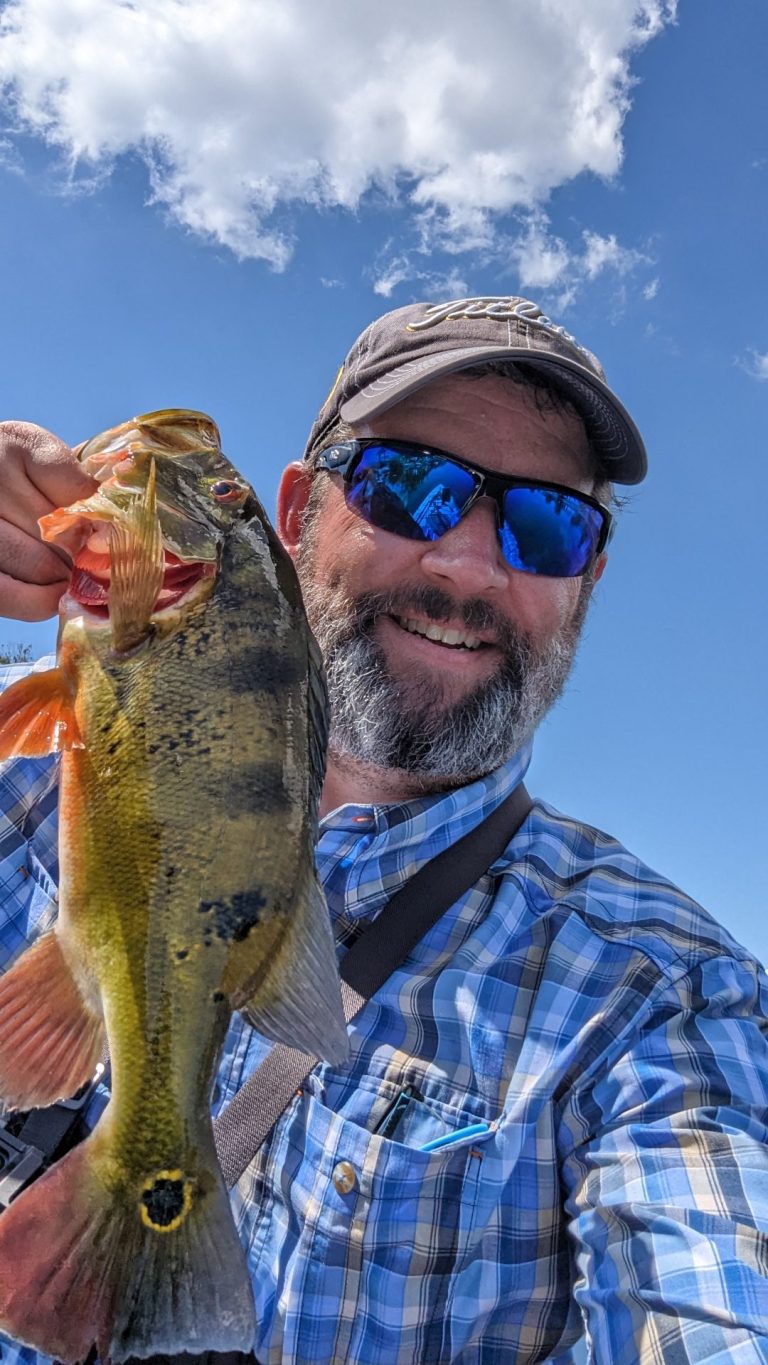BFS for Bass Fishing – Mastering Modern Finesse Techniques in 2024
Introduction to BFS Fishing
Table of Contents
Getting the Hang of Bait Finesse System
When I first stumbled upon the Bait Finesse System (BFS), I was hooked by the idea of using BFS for bass fishing. Shimano was one of the first to mass-manufacture BFS reels to fill the demand of Japanese anglers chasing ultra-cautious bass and jittery trout. These reels are perfect for tossing lightweight lures with pinpoint accuracy, making them a blast for ultralight anglers like me who love a good challenge.
BFS reels usually come with shallow, ultralight spools and advanced braking systems. These features are crucial for reducing spool rotation resistance, letting you cast smoother and farther even with the lightest lures. The gear ratios in BFS reels typically range from 6.3:1 to 8.9:1, giving you the speed and power to handle various fishing situations. But that 8.9:1 ratio may not be as fast as it seems due to the smaller spools and lower inches per turn (IPT).
The light drags, with around 8lb max pressure, and high-performance ball bearings boost the overall performance of these reels. Because you will often be fishing with six or eight pound line (some even use two pound!), that light-sounding drag is plenty.
And speaking of sound, most BFS reels also come with a drag clicker. If you’re used to running 20-pound line (or heavier), you can just crank down the drag with little concern of a fish breaking your line. But, using lighter lines in BFS, even a 6-pounder can break you off if you’re playing the power game and trying to horse the fish in. So the drag clicker is a feature I really appreciate knowing when that big fish is making a strong run. It’s adding one more of my senses to the equation.
| Feature | Description |
|---|---|
| Spool Type | Shallow, ultralight |
| Gear Ratio | 6.3:1 to 8.9:1 |
| Maximum Drag Pressure | 8lb |
| Braking System | Magnetic (Finesse Tuned Brake, Air Brake System) |
One of the coolest things about modern BFS reels is their magnetic braking systems. When I first started using them, it absolutely blew my mind how much easier they were to control than even a Nice Shimano reel from 10 years earlier.
Shimano’s Finesse Tuned Brake and Daiwa’s Air Brake System are popular designs that offer dynamic braking mechanisms. These systems improve casting accuracy and distance, making it easier to target those sneaky bass hiding in tight spots, while simultaneously reducing the potential for backlashes. It’s pretty remarkable.
BFS rods and reels are built for precision casting of smaller baits. If you need absolute distance, I still think spinning has the edge, but I haven;t used a spinning rod in over 2 years! Being able to palm the reel gives you more sensitivity, letting you feel more bites and have better control over your presentations. This is especially useful when fishing in tight quarters such as an overgrown creek.
If you want to go deeper on specific aspects of BFS fishing, check out our detailed guides on bfs rod selection and bfs reels. For those looking to up their fishing game, our articles on bfs lures and bfs line and leaders offer valuable tips.
In short, the Bait Finesse System is a relatively fresh approach to bass fishing that offers precision, control, and better sensitivity. As a bonus, it even makes those dinkfest days a ton of fun, because you’re essentially using an ultralight baitcaster!
But Whether you’re a seasoned angler or just starting out, BFS fishing can take your fishing experience to the next level. I’ve caught at least 14 personal bests (PB’s) since switching over to BFS.
Here’s a quick comparison of some key features in BFS reels:
| Feature | Description |
|---|---|
| Shallow Spool | Easier line release for lighter lures |
| Magnetic Braking Systems | Enhanced casting accuracy and distance |
| Gear Ratios | 6.3:1 to 8.2:1 |
| Light Drags | Around 8lb maximum pressure |
| High-Performance Ball Bearings | Minimize spool rotation resistance |
| Clicker Drag | Audible indication and added control |
| Palmable Design | Better control and sensitivity during retrieve |
For more detailed info on BFS reels, check out our guide on bfs reels.
Knowing these components helps you make smart choices when picking the best BFS reel for bass fishing. By focusing on these features, you can set up your gear for lighter lures and improve your overall fishing game. For tips on setting up your BFS combo, visit our article on optimizing for lighter lures.
Setting Up Your BFS Combo
Alright, let’s get your BFS (Bait Finesse System) combo dialed in for bass fishing. A good setup can make all the difference when you’re tossing those lighter lures and reeling in the big ones.
Getting the Most Out of Light Lures
Here’s how to tweak your gear for the best performance with lighter lures.
Reel Setup
Your BFS reel is the star of the show. It’s built to handle those featherweight lures like a champ. Follow these steps to get it just right:
- Crank Up the Brakes: Start by tightening the brakes all the way.
- Tweak the Tension Knob: Loosen the tension knob bit by bit until the spool can wiggle just a tad. This reduces startup inertia and makes for smoother casts (Wired2Fish).
- Go Shallow: Pick a spool that weighs less than 10g. Some of the lightest ones are around 3.7g (Fishing Discoveries).
Rod Selection
Your rod is just as important. A good BFS rod has a sensitive tip and a solid backbone. This combo lets you cast small baits with precision. Use a smooth, fluid motion instead of whipping the bait to get the best distance and accuracy.
How light (or heavy) a lure you can cast is also dictated by the rod. This seems to be common sense, but so many people complain they can’t cast 1.5 gram or 1/16 oz lures when they’re using a rod rated for 1/8 to /8 oz lures! Match the rod to your intended lure sizes.
Because we’re dealing with a more precise style of fishing, the rods often don’t have the same range of lure weights as your normal casting rods. Percentage-wise, they probably have more. But real-world weight ranges are often tighter because you’re dealing with very light presentations.
Need more info? Check out our guide on bfs rod selection.

Line Choices
The right line can make or break your BFS setup. Here’s what I suggest: use braid to fluorocarbon leader. I know, I know; You might be in the “100% fluorocarbon” camp. And that makes perfect sense for a traditional set up.
But when you’re considering casting lures that weigh not only 1/8th ounce, but maybe even below 1/16th of an ounce, the line diameter and sensitivity matter. You will get at least 20% more casting distance with braided mainline. It weighs less, making casting more efficient and precise. And it’s more sensitive, especially useful for those light nights on a near-weightless lure as it slowly falls past the face of that lunker you’ve always known was in the lake.
I personally use an FG knot, and I use the Knot Assist 2.0 tool to make it easier to tie on the water. Here’s a video that shows how it works:
For more on why line diameter matters, check out our article on bfs line and leaders.
By fine-tuning your BFS combo, you’ll be ready to face the challenges of bass fishing with finesse. For more tips and tricks, don’t miss our section on bfs fishing techniques.
BFS Fishing Techniques
When it comes to BFS (Bait Finesse System) for bass fishing, knowing how to use finesse baits can make all the difference. BFS fishing is all about downsizing your tackle and using finesse techniques to catch more fish. Let me share some tips on how I use finesse baits to up my BFS fishing game.
Using Finesse Baits Effectively
BFS fishing is all about using smaller, lighter baits to attract fish, especially in pressured or clear water. Here’s a breakdown of some popular finesse baits and how I use them:
Dropshot
The dropshot rig is a must-have in my BFS toolkit. I use a small hook with a finesse worm or small baitfish imitation, rigged above a weight. This setup lets me present the bait off the bottom, making it irresistible to bass.
| Dropshot Setup | Description |
|---|---|
| Hook Size | #1 – #6 |
| Weight | 1/8 oz – 1/4 oz |
| Bait | 3″ – 4″ finesse worm |
Wacky and Neko Rigging
Wacky and Neko rigs are perfect for picky bass. For the wacky rig, I hook a soft plastic worm through the middle, letting both ends wiggle as it sinks. For the Neko rig, insert a nail weight into one end of the worm, giving it a unique fall and action.
- Wacky Rig: Use a 4″ – 5″ worm, hook size #1.
- Neko Rig: Use a 4″ – 5″ worm, nail weight 1/32 oz – 1/16 oz.
Texas Rig
The finesse Texas rig is another effective technique. I use a small, weedless hook with a soft plastic bait, rigged with a light bullet weight. This rig lets me fish through vegetation and cover without getting snagged.
| Texas Rig Setup | Description |
|---|---|
| Hook Size | 2 – 1/0 |
| Weight | 1/32 oz – 1/8 oz |
| Bait | 2″ – 4″ creature bait (worms work too) |
Crankbaits and Topwater Baits
For BFS fishing, I like using downsized crankbaits and topwater baits. Small crankbaits like 1/8 oz models work well for targeting bass in shallow water. For topwater action, I use small poppers or walking baits, which can trigger explosive strikes.
- Crankbaits: 1/8 oz, 2″ – 3″ length.
- Topwater Baits: 1/8 oz – 1/4 oz, 2″ – 3″ length.
Using these finesse baits effectively requires the right gear and techniques. I always make sure my BFS setup is optimized for lighter lures, as discussed in our section on optimizing for lighter lures.
I also pay close attention to the line diameter, as it plays a big role in bait presentation and sensitivity. For more on this, check out our article on bfs line and leaders.
By mastering these finesse bait techniques, you can boost your BFS fishing experience and increase your chances of landing more bass. For more tips and tricks on BFS fishing, don’t forget to explore our bfs fishing techniques section.
FAQ’s
What are the Best BFS Bass Lures?
If you have a crankbait, a topwater, some wacky rigs, and a ned rig, you’ll catch fish most of the time.
What’s the point of BFS fishing?
Bait Finesse System, or BFS, allows you to cast light lures (like even trout magnets!) on baitcasting gear, which are more efficient, better balanced, and often more precise. Plus, it’s just so much fun!
What’s the Best BFS Rod for the Money?
It’s kind of hard to beat the Handing Magic L for a bass-focused budget BFS rod. At any price, I think the Hunt BFS rods from Kistler are the best in the world.
What’s the Best BFS Reel for the Money?
When it comes to performance vs price, the Doviello Acura is king. there simply isn;t a better value. The best all-around BFS reel that is capable of everything from bass to trout to panfish is the Shimano Aldebaran BFS.






